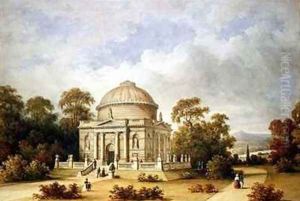Henry Edmund Goodridge Paintings
Henry Edmund Goodridge was an English architect born in 1797, known for his contribution to the architecture of the Georgian and early Victorian periods. Although not as widely recognized as some of his contemporaries, Goodridge left a significant mark on the architectural landscape of Bath, where he primarily worked, and on several other areas in England. His designs ranged from grand public edifices to elegant private residences, showcasing a versatility and a keen eye for the neoclassical style that was popular during his time.
Goodridge's architectural journey began after his education, which likely included training under an established architect, as was customary during the period. By the early 1820s, he had established himself in Bath, a city renowned for its Roman and Georgian architectural heritage. Here, Goodridge embarked on a career that would see him design a variety of buildings, including churches, villas, and civic buildings. One of his most notable works is Beckford's Tower (1826-1827), a neoclassical folly on the outskirts of Bath, built for the wealthy eccentric William Beckford. The tower is a testament to Goodridge's skill in blending imaginative design with practical functionality, serving both as a retreat for Beckford and as a statement of architectural beauty.
Throughout his career, Goodridge demonstrated a mastery of the neoclassical style, characterized by its symmetry, grandeur, and incorporation of classical elements such as columns and pediments. However, he was not averse to experimenting with other styles. This adaptability is evident in some of his other notable works, such as the restoration of Prior Park, a Palladian mansion in Bath, and the design of several Gothic revival structures. His contributions to the architectural fabric of Bath and other regions earned him a respectable place among the architects of his era.
Despite his achievements, Goodridge did not achieve the same level of fame as some of his contemporaries, such as John Nash or Augustus Pugin. Nonetheless, his work continues to be celebrated for its elegance, innovation, and the manner in which it complements the historical and aesthetic context of its locations. Henry Edmund Goodridge's legacy is preserved in the buildings he designed, which continue to be admired for their architectural significance and beauty.
Goodridge's death in 1864 marked the end of a career that had significantly contributed to the architectural heritage of Bath and beyond. His designs remain a lasting testament to his vision and skill, reflecting the architectural trends and preferences of his time. Through his work, Goodridge played a part in shaping the architectural narrative of the 19th century, leaving behind a legacy that continues to inspire and enchant those who appreciate the enduring beauty of neoclassical architecture.
